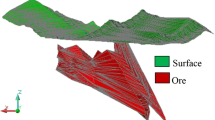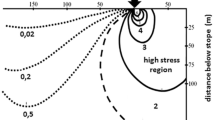Abstract
Coarse arches are a common issue in caving mines where large fragments are expected. These arches interrupt ore flow in drawpoints, decreasing available draw area, and also increasing the possibility of non-uniform draw, which can increase fine migration, mud-rush risk, and induced stress in the caved column. Moreover, hang-up removal is operationally complex and dangerous. The literature on gravity flow indicates that coarse arches are mainly influenced by the ratio between the rock fragments and the size of the opening and stresses, but some key variables have not been quantified. Here, the influence of fragment-size distribution and drawbell geometry on hang-up formation is analyzed through controlled laboratory experiments in a physical model. Results show that drawbell parameters, such as length, width and angle are relevant parameters in hang-up events. In particular, the ratios DL/d80 and DW/d80 as well as VDB/Vp are key to hang-up events, the probability of which will decrease when these ratios increase.








Similar content being viewed by others
Abbreviations
- α :
-
Drawbell angle (between extraction drifts, in the minor pillar)
- β :
-
Drawbell angle (between production drifts, in the mayor pillar)
- λ i :
-
i Scaled factor (Here, i = {m, v, l, ρ, g, ϕ})
- Cu:
-
Coefficient of uniformity (Cu = d60/d10)
- d i :
-
Fragment size such that i % of the particles are smaller.
- DBi :
-
Drawbell i (Here, i = {1, 2, 3, 4})
- D W :
-
Drawpoint width
- D L :
-
Drawbell length (measured in the drawbell’s bottom)
- H g :
-
Mean mass between hang-ups.
- LHD:
-
Load Haul Dump equipment
- T L :
-
Top drawbell length
- T W :
-
Top drawbell width
- V DB :
-
Drawbell volume
- V p :
-
Particle volume
References
Baiden G (2017) Telerobotics for hang-up assessment and removal—an idea whose time has come. In: Australian Centre for Geomechanics (ed) Proceedings of the first international conference on underground mining technology, pp 597–607
Beus MJ, Pariseau WG, Stewart BM, Iverson SR (2001) Design of ore passes. In: Hustrulid W, Bullock R (eds) Underground mining methods: engineering fundamentals and international case studies, pp 627–634
Brzovic A, Vallejos J, Arancibia E, Burgos L, Delonca A, Gaete M, Barerra V (2016) Analysis and modelling of the fragmentation process—case studies at El Teniente Mine. In: AusIMM (ed) Proceedings of the seventh international conference on mass mining, Sydney, pp 305–310
Bunker KA, Campbell AD, O’Toole D, Penney, A (2015) Guidelines for orepass design in a sublevel cave mine. In: Potvin Y (ed) Proceedings of the international seminar on design methods in underground mining, pp 585–600
Castro R (2006) Study of the mechanisms of gravity flow for block caving. PhD Thesis, University of Queensland, Brisbane
Castro R, Pineda M (2015) The role of gravity flow in the design and planning of large sublevel stopes. J S Afr Inst Min Metall 115(2):113–118
Castro R, Trueman R, Halim A (2007) A study of isolated draw zones in block caving mines by means of a large 3D physical model. Int J Rock Mech Min Sci 44(6):860–870. https://doi.org/10.1016/j.ijrmms.2007.01.001
Castro R, Gómez RE, Hekmat A (2016) Experimental quantification of hang-up for block caving applications. Int J Rock Mech Min Sci 85:1–9. https://doi.org/10.1016/j.ijrmms.2016.02.005
Chen Q, Qin S, Chen Q (2019) Numerical simulation of ore particle flow behaviour through a single drawpoint under the influence of a flexible barrier. Geofluids. https://doi.org/10.1155/2019/6127174
Codelco (2009) Caracterización geotécnica estructural—Proyecto Mina Chuquicamata Subterráneo—Ingeniería Básica (Geotechnical characterization—Chuquicamata Underground Mine Project—preliminary engineering), División Codelco Norte (in Spanish)
Esterhuizen GS (2005) BCF version3.05—a program to predict block cave fragmentation. Technical reference and user’s guide
Gómez R, Castro R, Casali A, Palma S, Hekmat A (2017) A comminution model for secondary fragmentation assessment for block caving. Rock Mech Rock Eng 50:3073–3084. https://doi.org/10.1007/s00603-017-1267-2
Hadjigeourgiou J, Lessard JF (2007) Numerical investigation of ore pass hang-up phenomena. Int J Rock Mech Min Sci 44:820–834. https://doi.org/10.1016/j.ijrmms.2006.12.006
Hadjigeourgiou J, Lessard JF (2010) Strategies for restoring material flow in ore and waste pass systems. Int J Min Reclam Environ 24(3):267–282. https://doi.org/10.1080/17480931003658894
Hancock W (2013) Gravity flow of rock in caving mines: Numerical modelling of isolated, interactive and non-ideal draw. PhD Thesis, University of Queensland.
Hurtado JP (2014) Fragmentation back analysis at El Teniente 1993–2013. Internal Report, GRMD-SGL-INF-69-2014 (in Spanish)
Hurtado JP, Pereira J, Campos R (2007) Fragmentation back analysis, mines: Diablo Regimiento, Reno and Teniente 4 Sur. In: Final Report, NNM-ICO-GEO-INF No 003, Codelco (in Spanish)
IM2 Consulting (2006) Levantamiento y evaluación de prácticas de reducción secundaria (Review of Secondary breakage techniques). Santiago (in Spanish)
Jin A, Sun H, Ma G, Gao Y, Wu S, Meng X (2016) A study on the draw laws of caved ore and rock using the discrete element method. Comput Geotech 80:59–70. https://doi.org/10.1016/j.compgeo.2016.06.016
Kurniawan C, Setyoko TB (2008) Impact of rock type variability on production rates and scheduling at the DOZ-ESZ. In: Schunnesson H, Nordlund E (eds) Proceedings of the 5th conference and exhibition on mass mining, Lulea, pp 291–302
Kvapil R (2008) Gravity flow in Sublevel and panel caving—a common sense approach Sweden
Lopez S, Castro R (2018) Análisis de formación de colgaduras en el bloque 2 de la mina Esmeralda (Hang-up fomation analysis in Esmeralda mine, bloque 2). In: Castro R, Herazo Y (eds) UMining 2018—II Congreso Iberoamericano en Minería Subterránea y a Cielo Abierto. Santiago, pp 82–94 (in Spanish)
Maass S (2013) Alternativas tecnológicas para descuelgue de zanjas (Technologies alternatives in hang-up release). Master thesis, Universidad de Chile (in Spanish)
Nadolski S, Munkhchuluun M, Klein B, Elmo D, Hart C (2018) Cave fragmentation in a cave-to-mill context at the New Afton Mine part I: fragmentation and hang-up frequency prediction. Min Technol 127(2):75–83. https://doi.org/10.1080/14749009.2017.1351115
Nazeri H, Mustoe GGW, Rozgonyi TG, Wienecke CJ (2002) Implementation of a discrete element methodology for the modeling of gravity flow of ore in ore passes. In: Proceedings of the 5th American rock mechanics symposium and the 17th tunneling association of Canada conference, pp 1307–1313
Ngidi SN, Pretorius DD (2010) Impact of poor fragmentation on cave management. In: Potvin Y (ed) Proceedings of the 2nd international symposium on block and sublevel caving, Perth, pp 593–602
Nicholas DE, Srikant A (2004) Assessment of primary fragmentation from drill core data. In: Karzulovic A, Alfaro A (eds) Proceedings of the 4th international conference & exhibition on mass mining, Santiago, pp 55–58
Orellana LF (2012) Study of design variables for the continuous mining system through laboratory experiments. Master’s thesis, University of Chile
Power G (2004) Modelling granular flow in caving miners: Large-scale physical models and Full-scale experiments. PhD Thesis, University of Queensland, Brisbane.
Silva M, Hidalgo F, Pinochet S, Adams E (2018) Metodología para estimar la disponibilidad de área abierta en panel caving, mina El Teniente (Panel caving methodology for area availability, El Teniente mine). In: Castro R, Herazo Y (eds) UMining 2018—II Congreso Iberoamericano en Minería Subterránea y a Cielo Abierto (in Spanish)
SRK Consulting (2015) Chuquicamata underground project: fragmentation study update, Codelco [Internal Report]
Szwedzicki T (2007) Formation and removal of hang-ups in ore passes. Min Technol 116(3):139–145. https://doi.org/10.1179/174328607X191047
Viera E, Diez E (2014) Analysis of hang-up frequency in Bloque 1–2, Esmeralda Sur Mine. In: Castro (ed) Proceedings of the 3rd international symposium on block and sublevel caving, Santiago, pp 138–145
Acknowledgements
This work was funded by the CONICYT/PIA Project AFB180004. R. Gómez thanks to CONICYT PFCHA/DOCTORADO BECAS CHILE/2019–72180000.
Author information
Authors and Affiliations
Corresponding author
Ethics declarations
Conflict of interest
The authors declare that they have no conflict of interest.
Additional information
Publisher's Note
Springer Nature remains neutral with regard to jurisdictional claims in published maps and institutional affiliations.
Rights and permissions
About this article
Cite this article
Castro, R., López, S., Gómez, R. et al. Experimental Study of the Influence of Drawbell Geometry on Hang-Ups in Cave Mine Applications. Rock Mech Rock Eng 54, 1–10 (2021). https://doi.org/10.1007/s00603-020-02247-4
Received:
Accepted:
Published:
Issue Date:
DOI: https://doi.org/10.1007/s00603-020-02247-4




